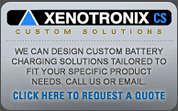Glossary for frequently used terms
Use the navigation links below to search for terms used in this site.
![]()
S
![]()
Sealed Lead-Acid Battery (SLA)
Refers to AGM and Gel Cell, VRLA batteries up to 30-50 Ah in capacity used in portable applications. See Valve Regulated Lead-Acid.
Secondary Battery
A battery designed to be charged and reused many times.
Self Discharge
The loss of capacity of a battery during storage due to internal chemical reactions.
Separator
A highly porous insulating material that retains electrolyte and prevents shorting between the positive and negative plates inside a battery.
Series Connection
The interconnection of batteries where the positive terminal of the first is connected to the negative terminal of the second, and so on. This results in increased voltage at the same rated capacity. For example, two 12 V 10 Ah batteries connected in series will yield a 24 V 10 Ah battery.
Slow Charge
Typically an over-night charge lasting about 14-16 hours at a charge current of 0.1C.
Standby
The use of batteries in which they are kept charged to be ready for use if the primary power for the connected equipment fails. Also called float or backup.
Starting Lighting Ignition (SLI) Battery
A battery designed to start internal combustion engines and to power the electrical systems in automobiles when the engine is not running. They have many thin lead plates which allow them to discharge a lot of energy very quickly for a short amount of time. Most SLI batteries will only tolerate being completely discharged a few times before being irreversibly damaged.
Starved Electrolyte Battery
A battery with little or no free fluid electrolyte. The electrolyte is held is woven glass mat separators between the plates. Does not refer to gel cell batteries that do have excess electrolyte, just not in a fluid form. See AGM battery.
State of Charge (SOC)
The percent of rated capacity to which a cell or battery is charged. For example, if 25 Ah are removed from a 100 Ah battery, its state of charge is 75% and the battery is at a 25% depth of discharge.
Stratification
A condition that occurs primarily in flooded lead-acid batteries, but may occur to a lesser degree in larger AGM batteries, when the acid concentration varies from top to bottom in the battery electrolyte. Periodic, controlled charging at voltages that produce gassing will redistribute the electrolyte. See Equalization.
Sulfation
A condition that afflicts unused and discharged lead-acid batteries; large crystals of lead sulfate grow on the plate, instead of the usual tiny crystals, making the battery extremely difficult to recharge.
Switch Mode Power Supply (SMPS)
A method of regulating power by turning the output on and off and adjusting the duty cycle (duty cycle = on time / off time). Duty cycle control may be either PWM (fixed frequency, pulse width modulated), FM (fixed on-time, frequency modulated), or a combination thereof. An SMPS is more efficient than a linear power supply, but is more complex and must be better filtered and shielded for electromagnetic emissions.



